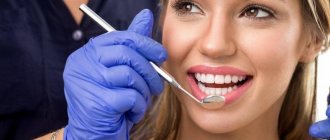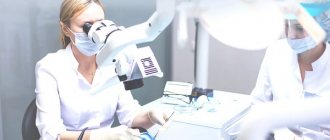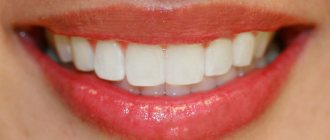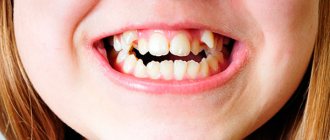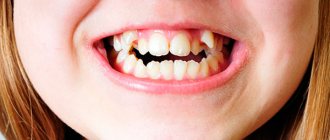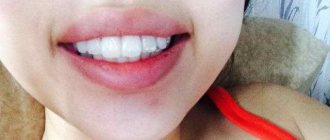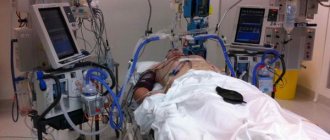- Signs of correct bite
- Types of malocclusion
- Why do you need to correct your bite?
- Until what age can a bite be corrected?
- Ways to correct a bite
- Aligners
- Trainers
- Veneers
- Bracket system
- Types of braces
- Which braces system should you choose?
- How long does it take to correct a bite?
- How to care for braces?
Malocclusion occurs in almost 80% of the Russian population. In a third of cases it requires orthodontic treatment. And it’s not just a matter of aesthetics - if you are often bothered by headaches, earaches and dizziness, then perhaps it’s a malocclusion. An orthodontist deals with the correction and prevention of malocclusions.
The most common misconception about bite is related to age. Many people think that it can only be corrected in childhood, but today, with the advent of new technologies, this can be done at any age.
In this article we will look at the causes and types of malocclusion and why it needs to be corrected. We will also tell you about treatment methods and dispel the most common fears. Orthodontist Olesya Milagina comments on current issues of orthodontic treatment for us.
Installation of braces in adulthood
Orthodontic treatment with braces in Russia goes back about thirty years. And in the USA, for example, bite correction with braces has been practiced for more than a hundred years. Russian orthodontists today often work with adults who simply did not have the opportunity to undergo this level of treatment in childhood. As a rule, such patients themselves turn to the dentist, less often - through the referral of related specialists. As a rule, people come to orthodontists for a beautiful smile, and not because of any pain. Most of those applying are women. Men are more relaxed about imperfect smiles, although doctors have recently noted an increase in the number of male patients.
Features of preparation for treatment
Orthodontic treatment begins with a consultation with a doctor. At the first appointment, the doctor examines the oral cavity to identify related problems and inflammatory processes. If there is caries, bleeding gums, tartar, a complete sanitation of the oral cavity is carried out. This is an important preparatory stage, since wearing braces can take several years.
Afterwards the orthodontic system is installed. Some solutions are prepared in a dental laboratory.
Does it make sense to get braces as an adult?
Correcting a pathological bite or incorrect position of teeth is, of course, not a matter of life and death. Rather, it is a matter of regaining self-confidence. The “curvature” of teeth has little effect on communication; after all, we perceive a person holistically, and not solely the state of his bite. But, you see, an open wide smile of any person will make him more attractive in our eyes. And only people who are not embarrassed to show off their teeth smile like that. Plus, when we talk about bite, it's not just about beauty, it's also about functionality. Nature intended that when chewing, the load on the teeth should be distributed evenly - this is only possible with straight teeth and a healthy bite. If this is not the case, then over time a person develops problems with the dental system: pain appears, clicks when opening and closing the mouth, etc. Therefore, orthodontic treatment for adult patients is not only possible, but also necessary.
Enamel deteriorates due to braces
When correcting a bite, braces are fixed to the surface of the enamel, and it stops being washed with saliva. This may weaken it, but with proper dental care and sufficiently effective self-hygiene, dental health is not in danger. To ensure that teeth remain healthy after bite correction, remotherapy is carried out before installing braces, professional hygiene is periodically performed during the treatment period, and the condition of the teeth is regularly monitored.
At what age does it make sense for adults to get braces?
In any case, there are no age restrictions. There are surmountable obstacles: the general condition of the teeth, periodontal and gum diseases, and possible common concomitant diseases. Absolute contraindications for installing braces for adults coincide with many other types of treatment: lack of teeth, tuberculosis, diabetes, a number of immune diseases, epilepsy, bone pathologies, blood diseases. If a person gets braces when he is over thirty, the treatment will be quite long, since tissue regeneration occurs more slowly due to age. Plus, skeletal growth has already been completed, and the position of the bones can be “corrected” only when they are still growing - in childhood and adolescence. However, dentists achieve excellent results with mature patients.
How much does treatment cost?
The cost of correcting a bite largely depends on:
- condition of the oral cavity (if caries is treated, inflammation is eliminated, the price increases);
- materials that will be used for the manufacture of orthodontic systems;
- technologies used by clinic doctors.
To get a quote, it is better to contact an orthodontist, who will examine the oral cavity, select the optimal technology together with the patient, and draw up a treatment plan. Doctors at our clinic can give an objective assessment of the condition of your teeth. During the consultation, the orthodontist will answer all your questions and tell you what stages of treatment will be used in a particular case. To make an appointment, call us or write through the feedback form.
Specifics of treatment with braces in adults
Adult patients should keep in mind that it is often necessary to remove teeth to achieve a high-quality result of orthodontic treatment. This does not mean that every patient needs it; removal is carried out only in cases where there is not enough space to restore the normal position of the teeth. Foreign orthodontists change the jaw size of adults using surgery. In Russia, orthognathic surgery is not yet particularly widespread due to the fact that our patients are extremely reluctant to agree to undergo operations. Let us repeat that this is just information about how it might be. In most cases, orthodontic treatment for adults is limited to simply installing braces.
Symptoms
Signs indicating the formation of a deep bite:
- The upper jaw grows and develops more rapidly than the lower jaw, surpassing it in parameters;
- The lower lip is too thin (in most cases!) and can be turned outward;
- Reduced depth of the gap located in front between the lips and cheeks;
- Lack of space between rows of teeth;
- Unnaturally small chin size.
Patients with a deep bite usually complain of difficulty biting and chewing foods, distorted pronunciation of certain sounds, and difficulty breathing.
Classification
Main types of deep bite:
| Name | Description | Peculiarities |
| Distal | The chin is reduced and slanted to the side, the face is shortened, the lower jaw is underdeveloped. When you smile, your teeth and part of your gums are visible. | Shapes:
|
| Neutral | It is not visually noticeable in either children or adults. The facial features are proportional. Accompanied by the formation of a supramental fold, in which the lower incisors overlap the upper ones. The chin is proportional to the rest of the face. | Affects the articulation of sounds and pronunciation. Only a specialist can determine a neutral deep bite. |
Consequences
A deep bite causes aesthetic discomfort and negatively affects the main function of the jaw – chewing. The mucous membranes are constantly injured, the front teeth are overloaded and bruxism (grinding) is formed.
Due to regular friction, tooth enamel wears down, which leads to increased sensitivity. A deep bite negatively affects the functioning of the maxillofacial joints, so treatment must begin as early as possible.
A long-term complication of the pathology is the gradual loosening of teeth and their loss already at 30-35 years of age. A deep bite provokes the development of many diseases - periodontitis, gingivitis and interdental gaps.
Photos before and after treatment
Diagnostics
To identify a defect and make a correct diagnosis, the orthodontist carefully examines the oral cavity and receives complaints from the patient. In order to recreate the exact contact of the dentition, casts are made from alginate mass. For a more detailed assessment of the condition of the oral cavity, computed tomography (CT), electromyography and orthopantomography are used.
Attention! Sometimes a specialist uses photographs of a person’s face taken from several angles to identify the occlusal relationships of the dentition.
Treatment
Correction of deep bites is recommended in childhood, but the necessary dental care is also provided to adult patients. The selection of treatment methods takes into account the form and degree of the anomaly:
- Plastic surgery for frenulum correction. The techniques used are frenectomy or frenulotomy. Laser exposure can be used;
- Bracket systems. They are able to correct the bite when the position of the incisors and molars is fully formed. Vestibular and lingual structures are used for treatment;
- Veneers, crowns. A cosmetic method that masks a deep bite, BUT does not eliminate the causes of its occurrence;
- Osteotomy. A surgical intervention that involves separating the palate and upper jaw from the bones and fixing them with plates and screws.
Attention! Elimination of malocclusion before the age of 6 years is recommended with the use of removable vestibular plates and retainers.
Treatment of a deep bite is accompanied by wearing a special plate and performing muscle gymnastics exercises.
At home
Self-treatment of deep bite is IMPOSSIBLE. However, at home you can speed up the healing process with the help of migymnastics. Provided that the exercises are performed correctly and regularly, it allows you to achieve excellent results.
When performing exercises, follow several rules:
- use all areas of the oral cavity,
- maintain the greatest amplitude of execution,
- take a break after each exercise,
- Perform exercises until your muscles feel slightly tired.
Prevention of functional disorders
A deep bite cannot be eliminated in 1-2 days; treatment with braces can take years. Simple preventive measures will help prevent functional disorders.
Among them:
- elimination of caries,
- correction of incorrect posture,
- eating solid foods (nuts, carrots),
- exclusion of pathologies of the skeletal system,
- prevention of somatic and chronic diseases.
The key to oral health is regular dental examinations (at least 2 times annually).
Patient reviews
“I wore braces for a long time - as a result, the bite improved a little, but still caused discomfort. To permanently solve the problem, the dentist suggested surgery. I had it performed under general anesthesia, the swelling subsided in just a few days, and 16 days after the operation I went back to work! Finally, my smile doesn’t give me any complexes, and eating food doesn’t cause any inconvenience!”
Lyudmila, 28 years old, Samara.
“After installing the braces system, I experienced severe pain for several days and could not even eat. The dentist warned about such consequences, so I bought painkillers in advance. After about a week I was completely accustomed to the braces. Now I’ve been wearing them for 6 months and the improvement in my facial proportions is already noticeable!”
Anastasia, 21 years old, Saratov.
“A deep bite has tormented me since childhood, but 2 years ago I finally decided to correct it and turned to an orthodontist. Initially, it was corrected with braces, but the doctor warned that it would be impossible to do without surgical intervention. Now my bite has been completely restored (after braces and surgery), even the oval of my face has visually stretched. For prevention, I continue to perform myogymnastics. I'm happy with the result."
Alexey, 34 years old, St. Petersburg.
Which braces are most often installed in adults?
It is most rational to choose metal braces: they are the most durable, and since the treatment will be long, this is one of the most important indicators. When it comes to minor corrections, aesthetic systems made of ceramics or artificial sapphires can be installed. But, let’s say, ceramic braces are quite fragile compared to metal ones. If the ceramic lock is chipped, you will need to remove it and install a new one. And this is a waste of time: when the lock is re-glued, the treatment can be considered to begin anew. When choosing a brace system, it is best to listen to the orthodontist’s recommendations - the doctor selects or combines types of structures so that the treatment is as comfortable as possible.
Pros and cons of braces
The system has many advantages. The main ones:
- Quickly fix the problem. To achieve the desired effect, long-term treatment is not necessary; the dental units take the correct position in a short period of time. This especially applies to structures made of metal.
- Many indications when the use of staples is applicable. These include both minor deviations and severe malocclusions that do not require surgical intervention.
- Possibility to combine with other therapeutic methods. Correction is applied individually or in combination, it all depends on the individual characteristics of the patient and the severity of the pathological process.
Flaws:
- External systems are visible to the naked eye. Even if you choose the most aesthetic options, they will still be noticeable to others. However, nowadays, orthodontic appliances have become a fashionable accessory, which indicates that the owner cares about his health. There are also lingual braces, hidden and unnoticeable.
- More careful oral hygiene is required. If you do not devote enough time to care, plaque will begin to accumulate and tartar will form. Professional cleaning in a dental office is recommended at least 3 times a year.
- Possibility of injury to mucous membranes (tongue, inner cheeks, gums). In the first time after installation, this phenomenon is not uncommon. But patients get used to the discomfort. In addition, you can purchase special wax to seal traumatic elements.
- Diet restrictions. This diet involves avoiding hard, viscous and sticky foods. Otherwise, the structure will quickly become unusable, and the duration of therapy will increase significantly.
Is it possible to correct an adult's bite without braces?
You can - with the help of aligners. These are orthodontic transparent aligners made of solid polymer. Despite their rather simple appearance, aligners cope well with both minor changes in the position of the teeth and quite serious pathologies of the dentofacial apparatus. When treating with orthodontic aligners, patient motivation is extremely important. Aligners are more often chosen by men - they think that this type of treatment is less problematic. But they often lack patience and remove the aligners as soon as they feel discomfort. And this is unacceptable if the patient expects a positive effect of treatment. Aligners need to be worn 22 hours a day - keep this in mind before choosing this treatment option. If you comply with this requirement, then treatment with braces will not be necessary - mouthguards are no less effective at restoring the anatomically correct position of the teeth and correcting the bite.
Types of malocclusion
How can you tell if your bite is wrong? Essentially, these are all deviations from the norm that nature has established.
Malocclusion occurs:
- distal - the upper jaw is pushed forward more than the lower jaw;
- mesial - the lower jaw is pushed forward more than the upper jaw;
- deep - the upper teeth overlap the lower ones by more than half their length;
- open - most of the teeth of the upper and lower jaws do not meet;
- cross - the left and right sides of the upper dentition protrude forward unevenly, and the upper and lower teeth meet with cutting edges.
What are the best “adult” braces according to reviews?
Most adult patients respond positively to lingual braces. They are fixed on the back surface of the teeth and are absolutely invisible to others. This type of braces has the lowest profile: the clasps of the systems are lower than all others, and therefore do not interfere with diction, do not irritate the mucous membranes, and do not scratch the tongue. Adults also often choose non-ligature ceramic braces - they are practically invisible, quite durable and cheaper than sapphire structures. When choosing a vestibular system that is fixed on the front surface of the teeth, it is worth considering that no matter what invisible material its clasps are made of, the orthodontic arch will always be noticeable. Therefore, you can safely choose classic metal braces. Ultimately, preference for a particular design comes down to its price.
Orthodontics at the Dent Ideal clinic
By choosing our clinic, you are choosing dentistry that keeps up with the times. Our specialists know the importance of a beautiful and healthy smile for every person - this is one of the main steps to success in any direction.
The clinic uses new technologies and has an experienced team of orthodontists who work with standard and complex cases. Our doctors do not rest on their laurels and regularly improve their skills and use innovative technologies recognized throughout the world. In our medical center, European service awaits you; with us you will get exactly the result you expected!
Retainers: why are they worn after braces are removed?
A retainer is a device that looks like an arch. It is placed on the back surface of the teeth when braces are removed. This way the new position of the teeth is secured. The ligamentous apparatus of the teeth has muscle memory, so no matter how we move the teeth, they will tend to return to their “original” position. Wearing a retainer is an essential part of orthodontic treatment. This is especially true for people over twenty-five years of age. A retainer is installed for at least two periods of wearing braces: for example, the patient wore them for one year, then the retainer will need to be worn for two years. Foreign orthodontists generally argue that you need to wear retainers constantly - this is the only way to guarantee that your teeth will remain straight. In general, after some time the retainer can be replaced with a night guard or plate. But some kind of structure supporting the new position of the teeth will definitely be needed - this is a classic. Unfortunately, patients often neglect this stage of treatment, experience relapses and begin to talk about the ineffectiveness and uselessness of orthodontic treatment in adulthood.
Can braces not help?
Wearing the system gives excellent results. If the dental units begin to diverge again, it means the patient did something wrong. Perhaps the doctor made mistakes at the diagnostic stage.
After therapy, wearing retainers (guards) is indicated. If this is not done, the incisors, canines and molars will quickly return to their previous position.
An important factor is the experience and professionalism of the orthodontist. If there is no positive effect, it is better to change the treating specialist. There are other reasons:
- unsuitable arc type;
- anatomical features of the structure of teeth;
- insufficient period of intervention.
What to do if braces don't help
Having discovered that wearing the structure turned out to be ineffective, you must first understand why this happened. When the system is dismantled, and the patient does not wear retainers (mouthguards) due to damage, loss, or does not even know that this should have been done, it is worth contacting the treating orthodontist. He will select the appropriate accessory. However, this applies to cases when no more than 2-3 days have passed since the removal of the structure. If a longer period has passed, the staples are reinstalled. The re-treatment will take less time than the first time, but it will last until the rows are aligned again.
If the doctor’s qualifications are weak, it is better to turn to another. Tactics depend on the factors that led to the problem.
How long should adults wear braces?
It is impossible to answer this question unambiguously: maybe one year, or maybe several years. Bite correction in adult patients is a long, labor-intensive process that requires patience and discipline. Therefore, orthodontists rarely persuade adults to straighten their teeth. If a person himself does not want this, then nothing will force him to conscientiously fulfill all the doctor’s demands. When treating adults with orthodontics, it is important that the dentist find a compromise between what he wants to achieve and what the patient wants to achieve. Orthodontists, of course, always strive to restore the perfectly aligned position of teeth, no matter how long it takes - at least three years, at least five years. The patient may get tired of the treatment and abandon it. The dentist’s main task is to honestly tell you how long the treatment will take and how it will proceed. And then hear whether the patient is ready to go this route.
How often is orthodontic treatment needed?
As an orthodontist with more than 20 years of experience, a large number of patients pass through me. But even with my experience in orthodontics, I meet people who refuse to believe and do not understand the whole situation with the malocclusion of their teeth.
In our team of dentists, we also specialize in orthodontics. After all, a person often comes to dentistry simply with a problem of caries or pain, and then the doctor, without actually imposing anything on him - without selling, tells him “everything as it is,” and the patient falls into a stupor, thinking “well, how can this be! I just came to put a filling...”
Let's talk about the ability of patients to recognize the problem of malocclusion. And also - why correct the bite and how to correct the bite.
In fact, many people are not prepared for what the doctor will tell them.
With such patients one has to follow a certain pattern of behavior. That is, we meet for the first time, I tell him that the person heard something, he has not yet realized it.
Then he comes the next time, we repeat this conversation, only with details, and until I see that the person himself wants to change something in his body, until he himself wants it, I do not take him into treatment. Why? Because everyone knows that 50% of the success of treatment depends on the patient himself; if he is motivated and wants to understand how to correct a malocclusion, everything will work out; the doctor alone cannot do it.
Often in our practice, especially with adult patients, we use an interdisciplinary approach together with surgeons, implantologists and orthopedists. Because, as a rule, when a patient seeks orthodontic treatment, it turns out that there are still a number of issues that need to be resolved with doctors of other specializations. At this moment, we do comprehensive consultations that last an hour and a half, and as a result of this consultation, our patient has an understanding of what will need to be done in order to achieve the desired result.
Price of braces for adults in Moscow
To avoid misleading you, we will not indicate specific amounts. Because orthodontic treatment for adults is time-consuming and often requires additional or preparatory procedures, its overall cost cannot be low. But the opportunity to smile broadly without embarrassment is priceless at any age! Therefore, it makes sense to schedule a consultation with an orthodontist, no matter how old you are. After examination and research, the doctor will tell you the exact cost of treatment in your case.
What do you need to get braces?
First of all, a visual examination is prescribed and diagnostic methods are determined. A treatment plan is then developed. Before installation, oral cavity sanitation, professional reading and other hygienic procedures are carried out. After which the structure is fixed.
How much does it cost
The cost may vary significantly. It depends on the type of system, material, as well as the severity of the pathology. For detailed information, we recommend contacting the dentist by phone listed on the website or leaving a request.
How to install braces if you have implants and crowns
Most patients who turn to orthodontists are adults between 25 and 45 years old. In addition to dental problems, they may have individual units removed and restoration elements may be present. The possibility of installing staples depends on the clinical picture in a particular case.
Inlays and veneers are not a contraindication. However, it is sometimes quite difficult to attach corrective parts to them, so therapy may not give much results.
Locks are also fixed onto artificial crown parts when only the root remains of the unit. If major correction is not required, the restored incisor, canine or molar may not be connected to the system. Experts recommend installing temporary plastic or composite crowns before treatment. They are inexpensive and can be removed if necessary.
If there is an implant, installation of brackets is either undesirable or completely contraindicated. The pin cannot be moved, otherwise it will be rejected by soft tissues. If you leave it in a static position, the remaining units will not be able to move. Thus, therapy is permissible in rare cases when the implanted element does not interfere with the correction of the bite.
Braces and pregnancy - compatible or not
While carrying a child, planning such treatment is strictly not recommended. This is primarily due to the need to undergo X-ray examination (CT, etc.), which is contraindicated in an “interesting position.” In addition, in the first days after installation, to speed up the adaptation process, it is recommended to take painkillers, which is unacceptable for pregnant women.
If therapy has begun and the woman sees two lines on the test, there is no need to remove the staples. However, in this case, you must adhere to the following rules:
- take good care of the oral cavity;
- undergo regular preventive cleaning with a doctor;
- carry out sanitation (preferably before installing braces and pregnancy);
- have the latest X-ray images available to track the dynamics of the correction.
Despite the limitations and undesirability of therapy during gestation, there are obvious advantages of such an intervention:
- in a woman, the structure of the bone tissue changes, and the units shift quickly;
- there is enough time for hygiene procedures;
- you can choose unaesthetic, but the most effective metal accessories, since for a long time you will not have to speak in public and be embarrassed.
How long should you wear braces?
The duration of treatment is determined by the doctor based on the diagnostic results, depending on the severity of the pathology and the selected type of structure. Each case is considered individually; there are no general recommendations.
It is important to remember that before installation it is necessary to get rid of gingivitis, caries, stomatitis and other problems. Therapy lasts at least a year; a shorter period is not enough. There is no maximum limit; some will have to wear braces for several years.
Is it possible not to correct the bite?
If left untreated, improper jaw structure can lead to serious consequences:
- Loosening of tooth roots Uneven distribution of chewing load leads to increased wear of teeth. They tilt, become loose and can subsequently fall out.
- Gum Disease An incorrect bite makes oral care difficult. The accumulation of plaque and stone provokes gum inflammation. Due to improper distribution of chewing load, some areas are overloaded, which leads to periodontitis.
- Temporomandibular joint dysfunction Improper jaw closure is a common cause of chronic headaches and migraines. Leads to arthritis, arthrosis.
- ENT diseases The constant accumulation of pathogenic bacteria in the oral cavity is dangerous for the development of sinusitis, sinusitis, otitis, and sore throat.
- Impaired diction Abnormal arrangement of teeth interferes with correct pronunciation.
- Problems with the gastrointestinal tract Improper closing of the jaws is the cause of poor chewing of food, which negatively affects the functioning of the gastrointestinal tract.

